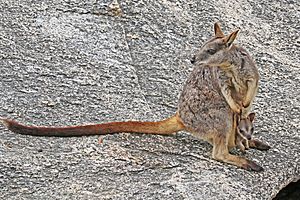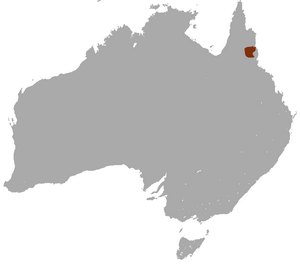Mareeba rock-wallaby facts for kids
Quick facts for kids Mareeba rock-wallaby |
|
|---|---|
 |
|
| Mareeba rock-wallaby with joey | |
| Conservation status | |
| Scientific classification | |
| Genus: |
Petrogale
|
| Species: |
mareeba
|
 |
|
| Mareeba rock-wallaby range (brown), within Australia | |
The Mareeba rock-wallaby (Petrogale mareeba) is a special type of rock-wallaby that lives in the rocky areas of northeastern Queensland, Australia. It is a rare animal, known for its ability to hop around cliffs and boulders. This wallaby was only recognized as its own unique species in 1992.
Contents
About the Mareeba Rock-Wallaby Family
The Mareeba rock-wallaby belongs to a group of seven very similar species. These are all part of the Petrogale genus, which means they are all rock-wallabies. Other members of this family include the Cape York rock-wallaby and the allied rock-wallaby. Scientists officially identified the Mareeba rock-wallaby as a separate species in 1992. Its name comes from the town of Mareeba, where it is often found.
Where the Mareeba Rock-Wallaby Lives
The Mareeba rock-wallaby is quite rare. It lives in the highlands west of Cairns in Queensland, Australia. You can find them on the tops of certain mountain ranges, from Mount Garnet to the Mitchell River and Mount Carbine. They also live inland near Mungana. You can even see these animals in their natural home at Granite Gorge Nature Park, which is about 60 kilometers inland from Cairns.
Protecting the Mareeba Rock-Wallaby
How We Classify Their Safety
Even though the Mareeba rock-wallaby is rare, it is listed as a "near-threatened species" by the IUCN. This means it could become endangered in the future if we don't protect it. However, under Queensland's Nature Conservation Act 1992, it is currently listed as "Least concern." This shows that different groups have different ways of looking at how safe the species is.
Surviving Bushfires
In December 2019, a very large fire swept through the Yourka Reserve near Einasleigh. This was part of the big bushfires in Australia that year. People worried that the Mareeba rock-wallaby population might not survive.
However, good news came! Scientists found that the wallaby population was actually doing well. They even spotted several new joeys (baby wallabies) in their mothers' pouches using motion-sensing cameras. The reserve manager, Paul Hales, explained that they had been doing "cool burns" for years. These controlled burns help to reduce thick tree growth. This allows native grasses like cockatoo grass and kangaroo grass to grow better. The December fire helped even more by thinning out the trees, letting sunlight reach the ground for the first time in 25 years. This new growth of grasses helps to support ground-dwelling animals like the rock-wallabies.


